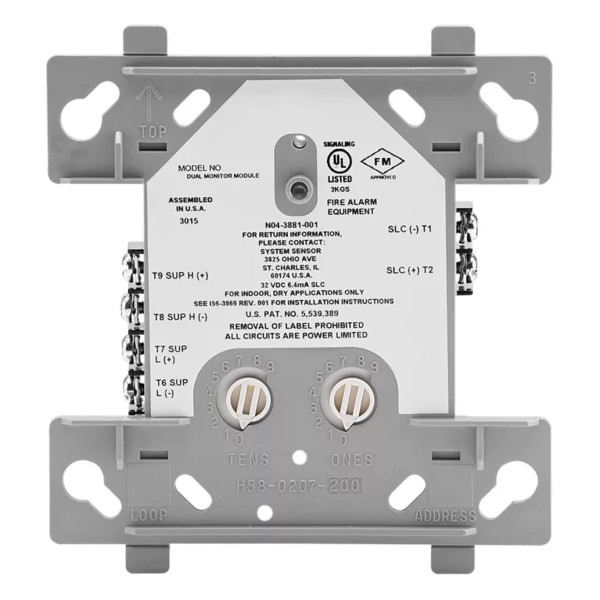- Built-in type identification automatically identifies this device as two monitor modules to the control panel.
- Powered directly by the two-wire SLC loop. No additional power required.
- High noise (EMF/RFI) immunity.
- SEMS screws with clamping plates for ease of wiring.
- Direct-dial entry of address 01 – 159 on the MS-9600.
- LED flashes green during normal operation and latches on steady red to indicate alarm.
The MDF-300 Dual Monitor Module is intended for use in
intelligent, two-wire systems, where the individual address
of each module is selected using the built-in rotary switches.
It provides two independant two-wire fault-tolerant Initiating
Device Circuits (IDCs) at two separate, consecutive addresses. It is capable of monitoring normally open-contact
fire alarm and supervisory devices, or either normally open
or normally closed security devices. The module has a single
panel-controlled red LED indicator.
MDF-300 Applications
Use to monitor a zone of four-
wire smoke detectors, manual fire alarm pull stations,
waterflow devices, or other normally-open dry-contact alarm
activation devices. May also be used to monitor normallyopen supervisory devices with special supervisory indication at the control panel. Monitored circuit may be wired as
an NFPA Style B (Class B) Initiating Device Circuit. The
47K ohm End-of-Line Resistors (provided) terminate the Style
B circuit. Maximum IDC resistance is 1,500 ohms.
MDF-300 Operation
Each MDF-300 uses two of 99
(MS-9200) or 159 (MS-9600) available module addresses
on an SLC loop. It responds to regular polls from the control
panel and reports its type and the status (open/normal/short)
of its Initiating Device Circuit (IDC). A flashing LED indicates
that the module is in communication with the control panel.
The LED latches steady on alarm (subject to current limitations on the loop).
INSTALLATION
MDF-300 module mount directly
to a standard 4" (101.6 mm) square, 2.125" (53.975 mm)
deep, electrical box. They may also be mounted to the
SMB500 surface-mount box. Mounting hardware and installation instructions are provided with each module. All wiring
must conform to applicable local codes, ordinances, and regulations. These modules are intended for power-limited wiring only.
